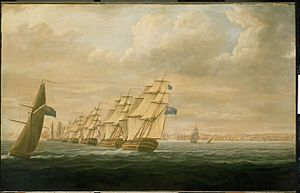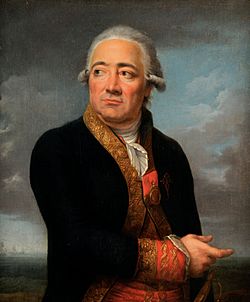Assault on Cádiz facts for kids
Quick facts for kids Assault on Cádiz (1797) |
|||||||
|---|---|---|---|---|---|---|---|
| Part of the French Revolutionary Wars | |||||||
 Nelson's Blockading Squadron at Cádiz 1797 by T. Buttersworth, oil on canvas. |
|||||||
|
|||||||
| Belligerents | |||||||
| Commanders and leaders | |||||||
| Casualties and losses | |||||||
| 3 armed boats sunk Victory's launch driven ashore |
3 armed boats captured | ||||||
The Assault on Cádiz was a series of attacks by the British navy on the Spanish port city of Cádiz in 1797. This happened during the French Revolutionary Wars. The British wanted to stop the Spanish fleet from leaving the port.
The British fleet was led by Lord Jervis and Sir Horatio Nelson. They arrived in the Gulf of Cádiz in June 1797. The British tried to bomb the city and attack the port. However, the Spanish built many small boats to defend their harbor. After several failed attacks, the British left. The Spanish won this battle, but the British continued to block the port until 1802.
Contents
Why the Battle Happened
In February 1797, the British navy won a battle against the Spanish fleet near Cape St. Vincent. But some important Spanish ships got away.
After this, Admiral Sir John Jervis sailed to Lisbon. The British navy leaders, called the Admiralty, told him to block and take over the Spanish port of Cádiz. Many damaged Spanish ships were hiding there. The British thought that Jervis's recent victory meant they could easily attack Cádiz.
The Blockade Starts
The British began to block Cádiz in 1797. This blockade continued without stopping until 1802. The British fleet stayed about 15 kilometers (9 miles) from the city.
A smaller group of British ships, led by Rear Admiral Thomas Louis, watched the Spanish fleet closely. Two British frigates (fast warships) stayed at the mouth of the harbor. Their job was to stop any food or supplies from reaching the Spanish ships. Nelson believed that cutting off supplies would force the Spanish fleet to come out and fight.
The main British fleet stayed further away, about 50 to 60 miles (80 to 97 kilometers) west of Cádiz. This way, the Spanish could not easily know how many British ships were there.
The Battle of Cádiz

Nelson was put in charge of the British ships closest to Cádiz. Every night, British boats would gather. They were armed with small cannons, swords, and knives. They also carried lamps, hammers, and ropes. Their goal was to capture any Spanish armed boats.
The Spanish had many gunboats and large launches. They used these to patrol the harbor at night. On July 3, the British boats, led by Nelson himself, attacked these Spanish boats. They chased the Spanish boats close to the city walls. The British captured two mortar-boats and one armed launch.
During this fight, Nelson faced Don Miguel Tregoyen, the leader of the Spanish gunboats. It was a very dangerous fight. Nelson fought hand-to-hand with the Spanish commander. Nelson later said he might have died if his loyal helper, John Sykes, had not been there.
At this time, Cádiz had over 4,000 soldiers. The city walls facing the bay had 70 cannons and 8 mortars. Other parts of the city also had many guns. This shows how strong the city's defenses were.
Nelson was ordered to bomb Cádiz. The first attempt did not work well because a large mortar was broken. The second bombing caused a lot of damage in the city and to the ships. Ten Spanish warships, including those of admirals Mazarredo and Gravina, quickly moved away from the bombs.
On July 8, Nelson planned another attack. But the wind was too strong. It was impossible to move the bomb ships into position. The next day, Nelson told Lord St. Vincent that he hoped they had done enough to make the Spanish fleet come out. If not, he would try again.
The British blockade continued for almost three more years. This stopped the Spanish fleet from leaving Cádiz until 1802. This helped the British navy become very strong in the Mediterranean Sea.
What Happened Next
After the attack on Cádiz, Nelson suggested a new plan to his commander. He wanted to lead an expedition against the town of Santa Cruz on the island of Tenerife. Lord Jervis allowed Nelson to choose the ships and officers for this mission. However, this expedition also ended in a defeat for Nelson.
The people of Cádiz made a popular song about their victory. It was sung in Spain during the 1800s:
- ¿De qué sirve a los ingleses
- tener fragatas ligeras
- si saben que Mazarredo
- tiene lanchas cañoneras?
- What good is for English
- having light frigates
- if they know that Mazarredo
- has gunboats?
See also
 In Spanish: Bloqueo de Cádiz para niños
In Spanish: Bloqueo de Cádiz para niños

